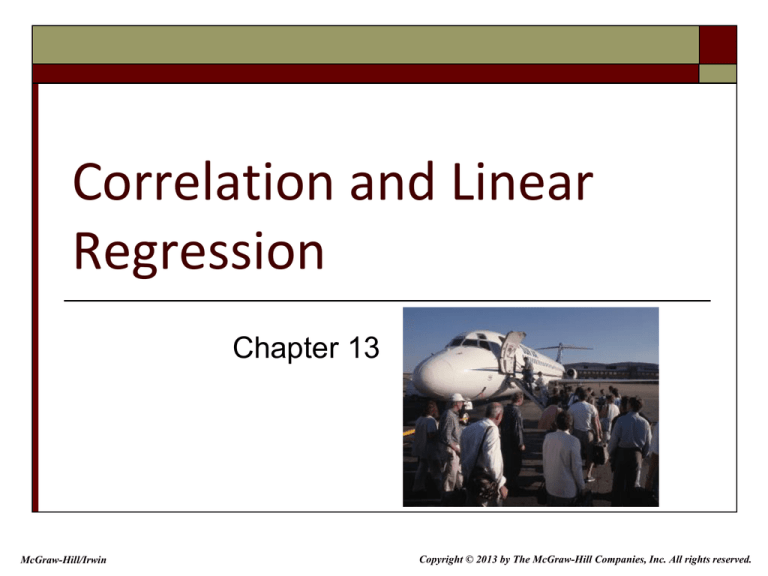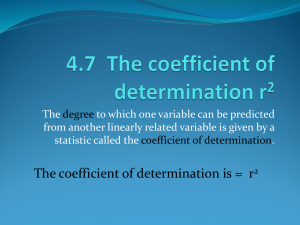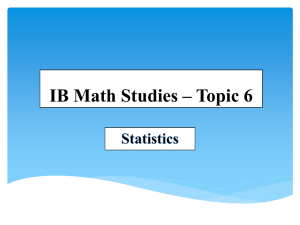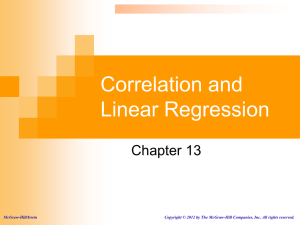
Correlation and Linear
Regression
Chapter 13
McGraw-Hill/Irwin
Copyright © 2013 by The McGraw-Hill Companies, Inc. All rights reserved.
LEARNING OBJECTIVES
LO 13-1 Define the terms dependent variable and independent variable.
LO 13-2 Calculate, test, and interpret the relationship between two variables
using the correlation coefficient.
LO 13-3 Apply regression analysis to estimate the linear relationship between
two variables
LO 13-4 Interpret the regression analysis.
LO 13-5 Evaluate the significance of the slope of the regression equation.
LO 13-6 Evaluate a regression equation to predict the dependent variable.
LO 13-7 Calculate and interpret the coefficient of determination.
LO 13-8 Calculate and interpret confidence and prediction intervals.
13-2
Regression Analysis – Introduction
In Chapter 4 we used Applewood Auto Group data to:
Show the relationship between two variables using a scatter diagram.
Show that as the age of the buyer increased, the profit for each vehicle also increased.
In this chapter, we will:
Use numerical measures to express the strength of the relationship between two variables.
Develop an equation to express the relationship between variables.
Use the equation to estimate one variable on the basis of another.
EXAMPLES
Does the amount Healthtex spends per month on training its sales force affect its monthly sales?
Is the number of square feet in a home related to the cost to heat the home in January?
In a study of fuel efficiency, is there a relationship between miles per gallon and the weight of a car?
Does the number of hours that students studied for an exam influence the exam score?
13-3
LO 13-1 Define the terms dependent
variable and independent variable.
Dependent vs. Independent Variable
The dependent variable is the variable being predicted or estimated.
The independent variable provides the basis for estimation. It is the
predictor variable.
In the questions below, which are the dependent and independent variables?
1. Does the amount Healthtex spends per month on training its sales force affect
its monthly sales?
2. Is the number of square feet in a home related to the cost to heat the home in
January?
3. In a study of fuel efficiency, is there a relationship between miles per gallon and
the weight of a car?
4. Does the number of hours that students studied for an exam influence the
exam score?
13-4
LO 13-1
Scatter Diagram Example
The sales manager of Copier Sales of America, wants to determine whether
there is a relationship between the number of sales calls made in a
month and the number of copiers sold that month. The manager selects
a random sample of 10 representatives and determines the number of
sales calls each representative made last month and the number of
copiers sold.
13-5
LO 13-2 Calculate, test, and interpret the relationship between
two variables using the correlation coefficient.
The Coefficient of Correlation, r
The coefficient of correlation (r) is a measure of the strength of the
relationship between two variables.
Shows the direction and strength of the linear relationship between two interval or ratioscale variables.
Ranges from –1.00 to +1.00.
Values of –1.00 or +1.00 indicate perfect and strong correlation.
Values close to 0.0 indicate weak correlation.
Negative values indicate an inverse relationship, and positive values indicate a direct
relationship.
13-6
LO 13-2
Correlation Coefficient – Interpretation
13-7
LO 13-2
Correlation Coefficient – Example
Using the Copier Sales of America data,
which is shown here in a scatter
plot, compute the correlation
coefficient and coefficient of
determination.
Using the formula:
13-8
LO 13-2
Correlation Coefficient – Example
What does correlation of 0.759 mean?
It is positive–a direct relationship between the number of sales calls and the
number of copiers sold.
0.759 is fairly close to 1.00–the association is strong.
13-9
LO 13-2
Testing the Significance of
the Correlation Coefficient
H0: = 0 (the correlation in the population is 0)
H1: ≠ 0 (the correlation in the population is not 0)
Reject H0 if:
computed t > critical t or computed t < −critical t
13-10
LO 13-2
Testing the Significance of
the Correlation Coefficient – Copier Sales Example
H0: = 0 (the correlation in the population is 0)
H1: ≠ 0 (the correlation in the population is not 0)
Reject H0 if:
computed t > critical t or
computed t < −critical t
d.f. = n − 2 = 10 − 2 = 8
Excel function: =tinv(.05,8)
13-11
LO 13-2
Testing the Significance of
the Correlation Coefficient – Copier Sales Example
Computing t, we get
Computed t (3.297) is greater than critical t (2.306).
Conclude: Reject H0.
Interpretation: The correlation in the population is not zero.
13-12
LO 13-2
Minitab Scatter Plots
Strong positive
correlation
No correlation
Weak negative
correlation
13-13
LO 13-3 Apply regression analysis to estimate the
linear relationship between two variables.
Regression Analysis
In regression analysis, we use the independent variable (X) to
estimate the dependent variable (Y).
The relationship between the variables is linear.
Both variables must be at least interval scale.
The least squares criterion is used to determine the
equation.
REGRESSION EQUATION An equation that expresses the linear relationship
between two variables.
LEAST SQUARES PRINCIPLE Determining a regression equation by
minimizing the sum of the squares of the vertical distances between
the actual Y values and the predicted values of Y.
13-14
LO 13-3
Linear Regression Model – General Form
Where:
13-15
LO 13-3
Regression Analysis –
Least Squares Principle
The least squares principle is used to obtain a and b.
13-16
LO 13-3
Computing the Slope of the Line
and the Y-intercept
where:
13-17
LO 13-3
Regression Equation – Example
Recall the example involving
Copier Sales of America.
The sales manager
gathered information on
the number of sales calls
made and the number of
copiers sold for a random
sample of 10 sales
representatives. Use the
least squares method to
determine a linear equation
to express the relationship
between the two variables.
What is the expected number of
copiers sold by a
representative who made
20 calls?
13-18
LO 13-4 Interpret the regression analysis.
Finding and Fitting the Regression
Equation – Example
Step 1: Find the slope (b) of the line
T heregressionequationis :
^
Y a bX
^
Y 18.9476 1.1842X
^
Y 18.9476 1.1842(20)
Step 2: Find the Y-intercept (a)
^
Y 42.6316
13-19
LO 13-5 Evaluate the significance of the
slope of the regression equation.
Testing the Significance of
the Slope – Copier Sales Example
H0: β = 0 (the slope of the linear model is 0)
H1: β ≠ 0 (the slope of the linear model is not 0)
Reject H0 if:
computed t > critical t or
computed t < −critical t
d.f. = n − 2 = 10 − 2 = 8, alpha = 0.05
Excel function: =tinv(.05,8)
13-20
LO 13-5
Testing the Significance of
the Slope – Copier Sales Example
Compute the t-statistic and make a conclusion:
t
b 0 1.1842 0
3.297
sb
0.3591
Conclusion: The slope of the equation is significantly different from zero.
13-21
LO 13-5
The Standard Error of Estimate
The standard error of estimate measures the
scatter, or dispersion, of the observed values around
the line of regression.
Formulas used to compute the standard error:
^
s y. x
(Y Y ) 2
n2
Y aY bXY
n2
2
s y. x
13-22
LO 13-5
Standard Error of the Estimate – Example
Recall the example involving
Copier Sales of America.
The sales manager
determined the least
squares regression
equation as given below.
Determine the standard error
of estimate as a measure
of how well the values fit
the regression line.
^
^
Y 18 .9476 1.1842 X
s y. x
(Y Y ) 2
n2
784.211
9.901
10 2
13-23
LO 13-5
Standard Error of the Estimate – Excel
13-24
LO 13-6 Evaluate a regression equation to predict the dependent variable.
Computing the Estimates of Y
Step 1: Using the regression equation, substitute the
value of each X to solve for the estimated sales
T omKeller
^
Y 18.9476 1.1842X
^
Y 18.9476 1.1842(20)
^
Y 42.6316
13-25
LO 13-6
Computing the Estimates of Y
Step 1: Using the regression equation, substitute the
value of each X to solve for the estimated sales.
Soni Jones
^
Y 18.9476 1.1842X
^
Y 18.9476 1.1842(30)
^
Y 54.4736
13-26
LO 13-6
Plotting the Estimated and the Actual Y’s
13-27
Assumptions Underlying Linear
Regression
LO 13-6
For each value of X, there is a group of Y values, and these
Y values are normally distributed. The means of these normal
distributions of Y values all lie on the straight line of regression.
The standard deviations of these normal distributions are equal.
The Y values are statistically independent.
13-28
LO 13-7 Calculate and interpret the Coefficient of Determination.
Coefficient of Determination
The coefficient of determination (r2) is the proportion of the
total variation in the dependent variable (Y) that is explained or
accounted for by the variation in the independent variable (X). It
is the square of the coefficient of correlation.
Value ranges from 0 to 1, or 0 to 100%.
Does not give indication on the direction of the
relationship between the variables.
13-29
LO 13-7
Coefficient of Determination (r2) – Copier
Sales Example
The coefficient of determination, r2, is
0.576 (or 57.6%).
Found by (0.759)2.
Interpretation:
57.6 percent of the variation
in the number of copiers sold
is explained, by the variation
in the number of sales calls.
13-30
LO 13-8 Calculate and interpret confidence and prediction intervals.
Confidence Interval and
Prediction Interval Estimates of Y
•A confidence interval reports the mean value of Y
for a given X.
•A prediction interval reports the range of values
of Y for a particular value of X.
13-31
LO 13-8
Confidence Interval Estimate – Example
We return to the Copier Sales of
America illustration. Determine a
95% confidence interval for all
sales representatives who make
25 calls.
13-32
LO 13-8
Confidence Interval Estimate – Example
Step 1: Compute the point estimate of Y.
In other words, determine the number of copiers we expect a sales
representative to sell if he or she makes 25 calls.
T heregressionequationis :
^
Y 18.9476 1.1842X
^
Y 18.9476 1.1842(25)
^
Y 48.5526
13-33
LO 13-8
Confidence Interval Estimate – Example
Step 2: Find the value of t
First, find the number of
degrees of freedom.
d.f. = n – 2 = 10 – 2 = 8.
Using a 95% confidence
level and d.f. 8, obtain t
using Appendix B.2.
t is 2.306.
13-34
LO 13-8
Confidence Interval Estimate – Example
Step 3: Compute X X
2
and
X X .
2
X X
2
13-35
LO 13-8
Confidence Interval Estimate – Example
Step 4: Use the formula above by substituting the numbers computed
in previous slides.
Thus, the 95% confidence interval for the average sales of all sales
representatives who make 25 calls is from 40.9170 up to 56.1882
copiers.
13-36
LO 13-8
Prediction Interval Estimate – Example
We return to the Copier Sales
of America illustration.
Suppose Sheila Baker, a
West Coast sales
representative, makes 25
sale calls.
Determine the 95% interval
estimate for the actual
number of copiers she will
sell.
13-37
LO 13-8
Prediction Interval Estimate – Example
Step 1: Compute the point estimate of Y when X = 25.
T heregressionequationis :
^
Y 18.9476 1.1842X
^
Y 18.9476 1.1842(25)
^
Y 48.5526
13-38
LO 13-8
Prediction Interval Estimate – Example
Step 2: Use the information computed earlier in the
confidence interval estimation example.
The number of copiers she will sell will be between about 24 and 73.
13-39
LO 13-8
Confidence and Prediction Intervals – Minitab
Illustration
13-40








